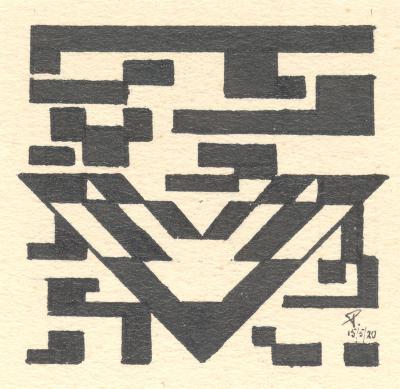In the period around the end of WWI, an atmosphere of fraternity emerges and a belief in the future grows, which is made patent with the term ‘humanitarian expressionism’. Artists are enthusiastic and have the impression that this is a pivotal moment, a new time, and that they are the harbingers of the art of the future, disillusioned by a ‘damaging’ history. Wassily Kandinsky (1866 - 1944) shall already point the way for artists in 1912 with his book Du spiritual dans l’art et dans la peinture en particulier towards this ‘tabula rasa’. In Antwerp as well as Brussels initiatives emerge in the context of this initiative.
Just before the end of the war, the group Kring Moderne Kunst (Modern Art Circle) is established in Antwerp. Antwerp artists assemble themselves to better embrace the social needs. Other groups such as Clarté and Lumière follow suit, but the Kring Moderne Kunst distinguishes itself by way of an outspoken evolution towards Abstract Art and Constructivism. The manifesto of the Moderne Kunst circle is published in Vlaamsch Leven on 20 Octobert 1918. In addition to Jozef Peeters as the secretary, other founding members are Edmond Van Dooren, Jos Leonard and Jan Cockx. An important show of force is inviting De Stijl frontman Theo Van Doesburg to deliver various lectures. These lectures shall accelerate the development of Abstract Art in Belgium.
Peeters and the members of the Kring Moderne Kunst organise three important conferences in 1920 and 1922. Above all, the 2nd Conference for Modern Art in Antwerp is a radical event for the Belgian, modernistic art scene. It is the first occasion whereby the Belgian avant-garde exhibits within an international context. The international participation is impressive with the delegation from the group affiliated with the publication Der Sturm, with Alexander Archipenko (1887 - 1964), Paul Klee (1879 - 1940) and Kurt Schwitters (1887 - 1948), among others, as well as the Italian Futurist Giacomo Balla (1871 - 1958).
In Brussels as well, shortly after the Armistice Day, a similar evolution comes about. The group and publication Le Geste announces the opening of Le Centre d’Art in December of 1919. This ambitiously engaged initiative consists of all of the necessary elements to serve as a platform: a lecture and exhibition hall, printer, publisher and bookstore. On 20 December 1919, the activities begin with an exhibition of posters by Pierre-Louis Flouquet and René Magritte, among others. Under the impulse of the brothers Pierre and Victor Bourgeois and the critic Maurice Casteels, Theo Van Doesburg is invited for a lecture, just as Peeters had done in Antwerp. After this event, the activity of the Centre d’Art stops, but the initiative is continued within the group and publication of 7 Arts. Important initiatives such as the booth of L’Equerre-7 Arts in the Salon de La Lanterne Sourde in 1923 gain momentum. In addition, entrepreneurs such as Flouquet and Victor Bourgeois ensure for international links with de Exposition Internationale d’Art Moderne in Geneva (1920), Exposition Internationale des Arts décoratifs in Monza (1925) and contributions to group exhibitions in the Musée de Grenoble (1927), inter alia.
Sergio Servellón
CC-BY-NC (Creative Commons 4.0)



